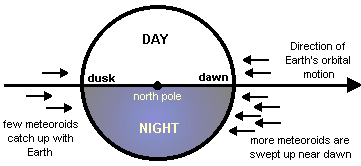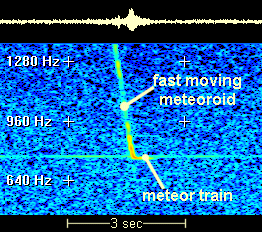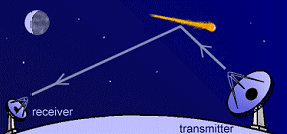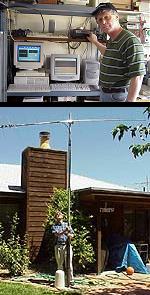 CLICK
HERE TO LISTEN CLICK
HERE TO LISTENto NASA's radio meteor detection system at the Marshall Space Flight Center in Huntsville, AL. (Requires Quicktime; it's free!) To hear the greatest number of meteors try listening between 3am and 9am Central Standard Time (0900 --1500 UT). Those are the hours around dawn in Alabama where the radio meteor detection system is located. A radio meteor ping sounds like this. back to spaceweather.com
Radio meteor rates listed under Space Weather Current Conditions on SpaceWeather.com are the maximum number of echoes per hour detected by an array of 88 - 110 MHz observing stations located in New Mexico (Stan Nelson), western Canada (Bud Haycock), and central California (Tony Phillips). The echoes, from distant FM radio stations, usually sound like brief snippets of speech or song that are counted in 10-second intvervals by dedicated computers running Pierre Terrier's Meteor 4 software.
Scientists Rob Suggs and Bill Cooke at the NASA Marshall Space Flight Center (Engineering Directorate) have also established a 67 MHz online radio meteor monitoring system in Huntsville, AL. Consisting of a 6-element Yagi antenna and an ICOM amateur radio, their setup detects video carrier signals from Channel 4 TV transmitters around the southeastern USA. All of the transmitters are over the horizon as viewed from the Marshall Space Flight Center, so it is normally impossible to detect them. But when a meteor races by, the distant TV signals bounce off the ionized meteor trail and down onto the MSFC antenna. A typical echo sounds like this. Radio meteor listening stations usually record 2 to 10 times more meteors than visual spotters in dark sky locations. The radio advantage is even greater during the day. Clouds, bright moonlight, and even sunshine are no impediment to radio meteor listening. In fact, the International Meteor Organization lists a dozen "daylight meteor showers" that peak after sunrise and are monitored almost exclusively by radio observations. The most intense of these is the Arietids which peak each year around June 8. They usually produce 60 to 100 radio detections per hour.  Above: The rate of meteor activity is usually greatest near dawn because the earth's orbital motion is in the direction of the dawn terminator. Earth scoops up meteoroids on the dawn side of the planet and outruns them on the dusk side. Both radio and visual meteor rates are
usually highest near dawn and lowest near dusk. That's because
the dawn sky is moving directly into the swarm of space dust
surrounding our planet. Just as bugs splatter on the front windshield
of a moving car, but not on the rear windshield, lots of meteoroids
hit the dawn sky, but very few can catch up with the sky at dusk.
 Above: Stan Nelson recorded this audio signal on April 11, 1999 while listening for meteor reflections from the powerful NAVSPASUR radar at 217 MHz. The pale yellow trace on top is the envelope of his ham receiver's loudspeaker output. The blue-colored time vs. frequency plot is the signal's dynamic spectrum. Click on the image to play the WAV-format audio recording. The dynamic spectrum of the radio meteor echo looks like an "L." The slanted, nearly vertical piece is the reflection from ionized air around the rapidly-moving meteoroid (sometimes called the "head" of the meteor). The doppler-shifted frequency of the reflection changes rapidly because the meteoroid moves across the line-of-sight of the transmitter at high speed. After the meteoroid disintegrates, all that remains is a slowly moving trail of ionized air. The velocity of the residual trail is low, typically no more than 0.02 km/s, compared to 30 - 70 km/s for the meteoroid. The reflection from the slowly moving gas does not experience a significant doppler shift, so it appears as a horizontal line (the bottom of the "L") in the dynamic spectrum. For more information about radio meteor observing, please read these Science@NASA headlines: Tuning in to April Meteor Showers Back to spaceweather.com |
 Meteor
showers happen when tiny bits of debris from comets (and sometimes
asteroids) strike Earth's atmosphere and disintegrate. Fast-moving
meteoroids ionize the air in their path and they leave behind
a trail that can briefly reflect radio waves from TV stations,
RADAR facilities, or AM/FM transmitters. A "radio meteor"
is
Meteor
showers happen when tiny bits of debris from comets (and sometimes
asteroids) strike Earth's atmosphere and disintegrate. Fast-moving
meteoroids ionize the air in their path and they leave behind
a trail that can briefly reflect radio waves from TV stations,
RADAR facilities, or AM/FM transmitters. A "radio meteor"
is  Left: Radio
amateur Stan Nelson of New Mexico is a longtime radio meteor
observer.
Left: Radio
amateur Stan Nelson of New Mexico is a longtime radio meteor
observer.